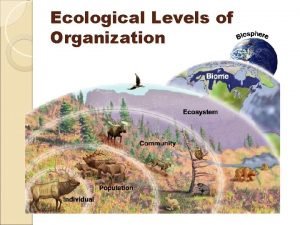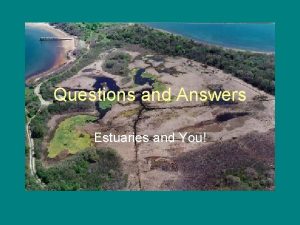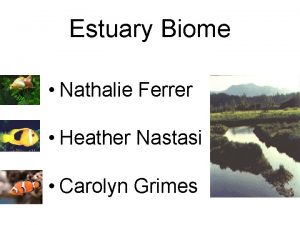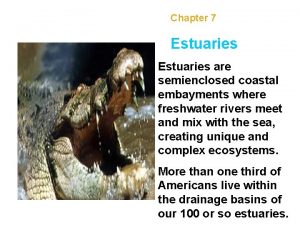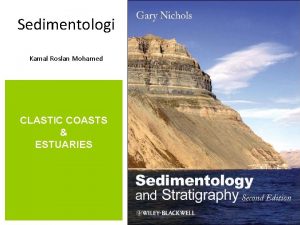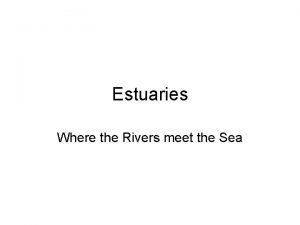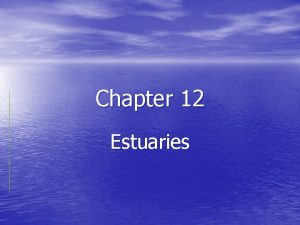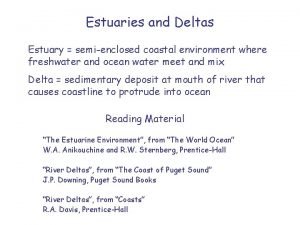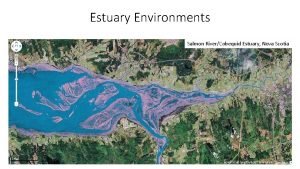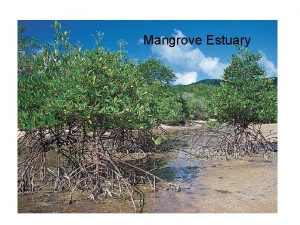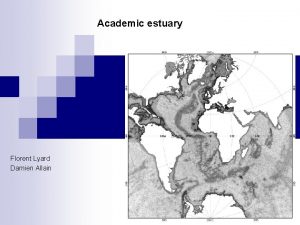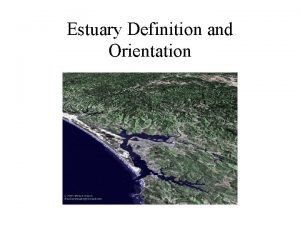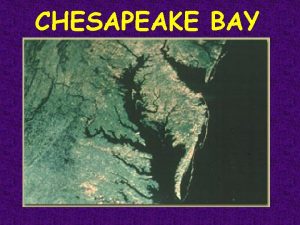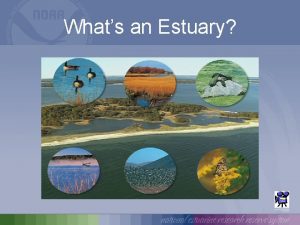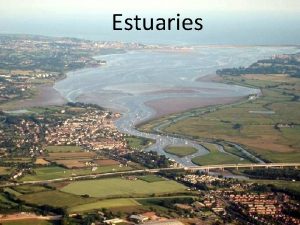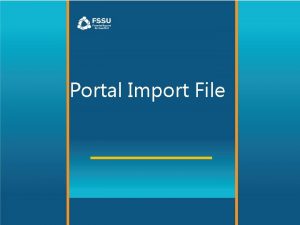California Estuary Monitoring Workgroups Estuary Portal Instructions for





















































- Slides: 53

California Estuary Monitoring Workgroup’s Estuary Portal Instructions for Comments • • • Please send all comments to Stephanie Fong (State and Federal Contractors Water Agency) at sfong@sfcwa. org by July 19. Comments about overarching issues and specific issues are requested. aaaa Please be sure to include the page number of the slide you are commenting on with your comments. Thank you 1

Home Safe to Drink Safe to Swim Safe to Eat Fish Ecosystem Health Stressors & Processes Contact Us Home Eco Health Estuaries California Estuaries …………………. . ………………………………………………………………. . ……… QUESTIONS ANSWERED Ø Cal/EPA Ø What are estuaries, and why are Ø Natural Resources Agency they important? Ø Where are California’s estuaries? Ø About the California Water Quality Monitoring Council Ø How healthy are California’s estuaries? Ø What’s being done to protect them? ESTUARIES Ø How can I be part of the solution? Ø Stressors Ø Laws, Regulations & Standards Ø Research Ø Monitoring Programs, Data Sources & Reports Ø Restoration & Management What are estuaries? Estuaries are partly enclosed bodies of water where fresh water coming down the rivers mixes with salt water from the sea. A range of coastal landforms fits this description, including bays, lagoons, harbors, inlets, and some wetlands. There are many types of estuaries in California including • bar-built, • open river mouths, and • perennially tidal estuaries. 2

Home Safe to Drink Safe to Swim Safe to Eat Fish Ecosystem Health Stressors & Processes Contact Us Home Eco Health Estuaries Where are California’s Estuaries? …………………. . ………………………………………………………………. . ……… QUESTIONS ANSWERED Ø Cal/EPA Ø Natural Resources Agency Ø About the California Water Quality Monitoring Council ESTUARIES Ø Stressors Ø Laws, Regulations & Standards Ø Where are California’s estuaries? Ø San Francisco Estuary Ø Santa Monica Bay Ø Morro Bay Estuary Ø Smith River Estuary Ø Klamath River Estuary Ø Mad River Estuary Ø Noyo River Estuary Ø Eel River Estuary Ø Russian River Estuary Ø Research Ø Monitoring Programs, Data Sources & Reports Ø Restoration & Management Hundreds of estuaries are found in California, including Santa Monica Bay, Morro Bay, and San Francisco Bay among others. It is the goal of this California Estuaries Portal to include comparable information on each of these estuaries. Initially, however, this Portal is focused on California’s largest estuary, the San Francisco Bay-Delta. 3

Home Safe to Drink Safe to Swim Safe to Eat Fish Ecosystem Health Stressors & Processes Contact Us Home Eco Health Estuaries Health How Healthy are California’s Estuaries? …………………. . ………………………………………………………………. . ……… QUESTIONS ANSWERED Ø Cal/EPA Ø How healthy are Ø Natural Resources Agency Ø About the California Water Quality Monitoring Council California’s estuaries? Ø SF Estuary Health Water Habitat ESTUARIES Living Resources Ecological Processes Stewardship Ø Stressors Ø Laws, Regulations & Standards Ø Research Ø Monitoring Programs, Data Sources & Reports Ø Restoration & Management How healthy are California’s estuaries? The health of the human body as a whole depends upon the health of its parts – the brain, the bones, the heart. The health of California’s estuaries is no different and depends on the well-being of its parts, also known as attributes, as defined by the authors of The State of the San Francisco Bay Report. These attributes include living resources, water, habitat, ecological processes, and stewardship. The initial focus of this Portal is on a robust evaluation of the health of Living Resources and Water for the SF Estuary. The remaining key attributes for the SF Estuary and all of the attributes for other California estuaries are under development. 4

Home Safe to Drink Safe to Swim Safe to Eat Fish Ecosystem Health Stressors & Processes Contact Us Home Eco Health Estuaries Protection What is Being Done to Protect California’s Estuaries? …………………. . ………………………………………………………………. . ……… QUESTIONS ANSWERED Ø Cal/EPA What’s being done to protect them? Ø What’s being done to Ø Natural Resources Agency California’s estuaries are being protected in a number of ways with protect California’s Ø About the California Water Quality Monitoring Council • Laws, Regulations, and Policies, • Federal • State • SF Estuary Policies and Plans • Research and Restoration, • Monitoring Programs, Data Sources, and Reports, and • Stewardship. [content in development] estuaries? ESTUARIES Ø Stressors Ø Laws, Regulations & Standards The initial focus of the Portal is on an evaluation of the policies and programs protecting the SF Estuary. More information on other California estuaries is under development. What laws, regulations, and policies protect California’s estuaries? Ø Research Ø Monitoring Programs, Data Sources & Reports Ø Restoration & Management California’s estuaries, and the organisms that live in them, are protected by many federal laws, regulations, and policies designed to prevent the degradation and destruction of • • Water Quality, Habitat, Living Resources, and Ecological Processes. Some of these protections, which government agencies enforce and uphold, and how they relate to California’s estuaries are described below. Please note: Simply having laws, regulations, and policies in place is not enough to protect California’s estuaries and other natural resources. Constant vigilance and effort are necessary to ensure healthy ecosystems and the continued existence of rare and listed species. Federal Laws, Regulations, and Policies 1. Endangered Species Act (ESA) 5

Home Safe to Drink Safe to Swim Safe to Eat Fish Ecosystem Health Stressors & Processes Contact Us Home Eco Health Estuaries Where San Francisco What is the San Francisco Estuary, and Why is it Important? …………………. . ………………………………………………………………. . ……… QUESTIONS ANSWERED Ø Cal/EPA Ø Natural Resources Agency Ø What is the SF Estuary, and why is Ø About the California Water Quality Monitoring Council Ø How healthy is the SF Estuary? ESTUARIES Ø Stressors it important? Ø What’s being done to protect the SF Estuary? < > Ø How can I be part of the solution? Ø Laws, Regulations & Standards Ø Research Ø Monitoring Programs, Data Sources & Reports Ø Restoration & Management What is the San Francisco Estuary? The San Francisco Estuary (SF Estuary) is a partly enclosed body of water where salt water from the Pacific Ocean mixes with freshwater from rivers draining the surrounding watershed. The SF Estuary is the largest estuary on the west coasts of North and South America and includes the Golden Gate Strait, San Francisco, San Pablo, and Richardson Bays (western Bays), Carquinez Strait, Suisun, Grizzly, and Honker Bays (eastern Bays), and the Sacramento-San Joaquin River Delta (Delta). The mixing of sea water and freshwater creates characteristic estuarine aquatic habitat that transitions from salty sea water to brackish (less salty) to freshwater. Tides bring water from the Pacific Ocean through the Golden Gate Strait into the estuary while California’s two largest rivers, the Sacramento and San Joaquin, contribute the greatest amount of freshwater to the estuary. The Sacramento and San Joaquin Rivers carry water from the Sierra Nevada and Cascade mountain ranges to the Delta where the transition from freshwater to sea water is observed. The river channels combine and fresh and salty water mix and move back and forth with the tides throughout the SF Estuary. Why is the San Francisco Estuary Important? The SF Estuary is a valuable ecological and economic resource. The natural resources in the SF Estuary are the building blocks of the economy, our communities, and ecosystems. 6

Home Safe to Drink Safe to Swim Safe to Eat Fish Ecosystem Health Stressors & Processes Contact Us Home Eco Health Estuaries Where San Francisco Health How Healthy is the SF Estuary? …………………. . ………………………………………………………………. . ……… QUESTIONS ANSWERED Ø How healthy is the SF Estuary? Ø Cal/EPA Ø Living Resources Ø Natural Resources Agency Ø Water Ø About the California Water Quality Monitoring Council ESTUARIES Ø Habitat Ø Ecological Processes Living Resources Water Habitat Ecological Processes Stewardship Ø Stressors Ø Laws, Regulations & Standards Ø Research Ø Monitoring Programs, Data Sources & Reports Ø Restoration & Management How healthy is the SF Estuary? The health of the human body as a whole depends upon the health of its parts – the brain, the bones, the heart. The health of California’s estuaries is no different and depends on the well-being of its parts, also known as attributes, as defined by the authors of The State of the San Francisco Bay Report. These attributes include living resources, water, habitat, ecological processes, and stewardship. The initial focus of this Portal is on a robust evaluation of the health of Living Resources and Water for the SF Estuary. The remaining key attributes for the SF Estuary and all of the attributes for other California estuaries are under development. 7

Home Safe to Drink Safe to Swim Safe to Eat Fish Ecosystem Health Stressors & Processes Contact Us Home Eco Health Estuaries Where San Francisco Health Living Resources What are SF Estuary Living Resources? …………………. . ………………………………………………………………. . ……… QUESTIONS ANSWERED Ø What are SF Estuary living Ø Cal/EPA resources? Ø Natural Resources Agency Ø Phytoplankton Ø About the California Water Quality Monitoring Council Ø Zooplankton Pictures of living resources that you can click on to get to details Ø Benthic Organisms Ø Fish ESTUARIES Ø Birds Ø Stressors Ø Mammals Ø Laws, Regulations & Standards Ø Plants < Ø Research Ø Monitoring Programs, Data Sources & Reports Ø Restoration & Management > What are SF Estuary living resources? Healthy estuaries support diverse and resilient populations of living resources, dominated by native species and broadly distributed across different habitats. These living resources include phytoplankton, zooplankton, benthic organisms, fish, birds, plants, and mammals. How do you evaluate the health of living resources? To evaluate the health of living resources, scientists have identified health indicators for the SF Estuary. Learn more about the most recent evaluation of the state of the SF Bay. (link to SOTB Report 2011) 8

Home Safe to Drink Safe to Swim Safe to Eat Fish Ecosystem Health Stressors & Processes Contact Us Home Eco Health Estuaries Health Concept Living Resources How do We Determine the Health of Living Resources? …………………. . ………………………………………………………………. . ……… QUESTIONS ANSWERED Ø How do we determine the STEP 1 Ø Cal/EPA Ø Natural Resources Agency Ø About the California Water Quality Monitoring Council Identify Key Attributes Water Habitat Ecological Processes Living Resources health of each attribute? Stewardship Ø Living Resources Ø Water STEP 2 Phytoplankton Define Focal Categories Ø Habitat Benthic Organisms Zooplankton Fish Ø Ecological Processes Ø Stewardship ESTUARIES Ø Stressors STEP 3 Ø Laws, Regulations & Standards Describe Health Indicators Ø Research STEP 4 Ø Monitoring Programs, Data Sources & Reports Visualize Trends Ø Restoration & Management Species Composition (e. g. native v. exotic) Native Richness over time Species Distribution Species Abundance over time Area occupied over time STEP 5 Identify & Evaluate Drivers Water (Quantity) Water (Quality) Habitat loss Predation Food Web Entrainment How do we determine the health of each living resources? Assessing the health of any one attribute can be a complicated process. Conceptual models, such as the one depicted above, can help us assess the health of each attribute by allowing us to identify important health indicators, their trends over time, and the types of drivers that cause changes in the health of the estuary. 9

Home Safe to Drink Safe to Swim Safe to Eat Fish Ecosystem Health Stressors & Processes Contact Us Home Eco Health Estuaries Where San Francisco Health Living Resources Phytoplankton What are Phytoplankton, and Why are They Important? …………………. . ………………………………………………………………. . ……… QUESTIONS ANSWERED Ø What are phytoplankton, and why Ø Cal/EPA are they important? Ø Natural Resources Agency Ø How and where are they monitored in the SF Estuary? Ø About the California Water Quality Monitoring Council Ø What are their trends in the SF Estuary? Ø How healthy are they in the SF ESTUARIES Estuary? Ø Stressors Ø What’s being done about it? Ø Laws, Regulations & Standards Ø Research What are phytoplankton? Ø Monitoring Programs, Data Sources & Reports Phytoplankton are small organisms that can be found floating in most water bodies. Like plants, they are primary producers, meaning that they convert light energy from the sun and carbon dioxide into the living matter of their bodies through photosynthesis. Phytoplankton from the SF Estuary fall into four broad categories: cyanobacteria, diatoms, green algae, and various flagellate groups. Ø Restoration & Management Why are they important? • Phytoplankton are the foundation of the aquatic food web. They feed everything from microscopic, animal-like zooplankton to multi-ton whales. Small fish and benthic organisms also graze on these creatures, and then those smaller animals are eaten by bigger ones. Changes in phytoplankton populations in the SF Estuary can have reverberations that are felt throughout the food web. • Phytoplankton can also affect elements of water quality, including • p. H, • Dissolved oxygen, 10

Home Safe to Drink Safe to Swim Safe to Eat Fish Ecosystem Health Stressors & Processes Contact Us Home Eco Health Estuaries Where San Francisco Health Living Resources Phytoplankton Monitored How and Where are Phytoplankton Monitored in the SF Estuary? …………………. . ………………………………………………………………. . ……… Phytoplankton Monitoring Stations QUESTIONS ANSWERED Ø What are phytoplankton, and why Ø Cal/EPA are they important? Ø Natural Resources Agency Ø How and where are they monitored in the SF Estuary? Ø About the California Water Quality Monitoring Council Ø What are their trends in the SF Estuary? Ø How healthy are they in the SF ESTUARIES Estuary? Ø Stressors Ø What’s being done about it? Ø Laws, Regulations & Standards Ø Research Ø Monitoring Programs, Data Sources & Reports Ø Restoration & Management How and where are phytoplankton monitored? Phytoplankton are monitored as part of the IEP’s Environmental Monitoring Program (EMP) by the California DWR’s Phytoplankton Study. Changes in their densities and distribution are documented in the SF Estuary, from San Pablo Bay east through the upper Estuary. Twenty-two sites are currently sampled monthly. They represent a wide range of habitats of varying sizes and physical conditions, including different types of water quality. Sites range from narrow, freshwater channels in the Delta to broad, estuarine bays. Phytoplankton density estimates are calculated in two ways, either by counting phytoplankton cells under a microscope or by measuring concentrations of chlorophyll a in the water. Scientists can use chlorophyll a, the most common green pigment in all photosynthetic organisms, as a proxy measure of phytoplankton biomass. Chlorophyll a is relatively easy to measure and is a fairly accurate estimate of phytoplankton volume. In the animation above, the size of the monthly mean chlorophyll measurements is represented by the relative size of the circles. 11

Home Safe to Drink Safe to Swim Safe to Eat Fish Ecosystem Health Stressors & Processes Contact Us Home Eco Health Estuaries Where San Francisco Health Living Resources Phytoplankton Trends What are SF Estuary Phytoplankton Trends? QUESTIONS ANSWERED …………………. . ………………………………………………………………. . ……… Ø What are phytoplankton, and why are they important? Ø Cal/EPA Ø How and where are they monitored Ø Natural Resources Agency in the SF Estuary? Ø What are their trends in the SF Ø About the California Water Quality Monitoring Council Pictures off trends graphs that you can click on to get to details Estuary? Ø How healthy are they in the SF Estuary? ESTUARIES Ø What’s being done about it? Ø Stressors Ø Laws, Regulations & Standards < Ø Research Ø Monitoring Programs, Data Sources & Reports Ø Restoration & Management > What are SF Estuary phytoplankton trends? Phytoplankton populations in the SF Estuary have been decreasing since 1985, particularly in Suisun Bay and in parts of the Central Delta. Larger phytoplankton, including some kinds of diatoms, are an important food source for the zooplankton that are favored by native fish, including delta smelt. In many parts of the SF Estuary, diatoms have either decreased or larger, single-celled phytoplankton have been replaced by smaller, species that are not as nutritious for zooplankton. Cyanobacteria, some of which can produce toxins that make humans and pets sick, have been increasing in portions of the SF Estuary. 12

Note to Reviewer • The graphs on slides 14 -15 will be presented as a slide carousel on slide 12. The viewer would see each graph and its caption by clicking on it in the carousel. There are 7 total graphs. • Each graph on slide 14 will be viewed individually, but all graphs on slide 15 will be viewed together for comparison. 13

Chlorophyll a Trends (1975 -2011) • This graph depicts the downward trend in chlorophyll a concentrations from 1975 to 2011 in 10 regions of the SF Estuary averaged by year. Decreasing chlorophyll a concentrations means less phytoplankton available for zooplankton, benthic organisms, and fish to eat. • This graph depicts the downward trend in chlorophyll a concentrations averaged by year over time in the South Delta and the stable trend in concentrations in the North Delta. Chlorophyll a Trends (1975 -2011) – Rivers Chlorophyll a Trends (1975 -2011) – Mid-Delta Chlorophyll a Trends (1975 -2011) - Upstream • This graph depicts the downward trend in chlorophyll a concentrations over time in the central Delta averaged by year and the fluctuations in concentrations in the eastern Delta Chlorophyll a Trends (1975 -2011) - Downstream • This graph depicts the downward trend in chlorophyll a concentrations over time in the lower Sacramento and San Joaquin Rivers averaged by year. There has been a recent upward trend since 2011. Chlorophyll a Trends (1975 -2011) – Low Salinity Zone 14

Phytoplankton Species Composition Trends • Text for this chart, • Text for this chart 15

Home Safe to Drink Safe to Swim Safe to Eat Fish Ecosystem Health Stressors & Processes Contact Us Home Eco Health Estuaries Where San Francisco Health Living Resources Zooplankton What are Zooplankton, and Why are they Important? …………………. . ………………………………………………………………. . ……… QUESTIONS ANSWERED Ø Cal/EPA Ø Natural Resources Agency Ø About the California Water Quality Monitoring Council Ø What are zooplankton, and why are Slide show – Photos SF Estuary zooplankton species (pictures on next slide are part of what will go here) they important? Ø How and where are they monitored in the SF Estuary? Ø What are their trends in the SF Estuary? Ø How healthy are they in the SF ESTUARIES Estuary? Ø Stressors Ø What’s being done about it? Ø Laws, Regulations & Standards Ø Research What are zooplankton? Ø Monitoring Programs, Data Sources & Reports Zooplankton are tiny, drifting or weakly swimming animals found in aquatic environments. The most common ones in the SF Estuary include copepods, cladocerans, rotifers, and mysids. Some zooplankton are native to the Delta, while others have been introduced. Ø Restoration & Management Why are they important? • Zooplankton are important food sources for larval and juvenile salmon, striped bass, and splittail, and small fish including delta smelt. Zooplankton species composition differs between salinity zones, resulting in different zooplankton communities between freshwater to brackish to salty environments. Thus their presence and abundance can indicate water types. Learn more about how zooplankton abundance is monitored in the SF Estuary. (link to zooplankton monitoring page (next slide)). 16

Photo of Limnoithona tetraspina, found in the Low Salinity Zone, a nonnative species that was first detected in 1993 Photo of Limnoithona sinensis, found in the freshwater zone, a nonnative species that was first detected in 1979 Photo of Eurytemora affinis, found in the Low Salinity Zone, a nonnative species that used to be the dominant source of fish food Photos of Pseudodiaptomus forebsi, found in the Low Salinity Zone, a nonnative species that was first detected in 1987 17

Home Safe to Drink Safe to Swim Safe to Eat Fish Ecosystem Health Stressors & Processes Contact Us Home Eco Health Estuaries Where San Francisco Health Living Resources Zooplankton Monitored How and Where are Zooplankton Monitored in the SF Estuary? …………………. . ………………………………………………………………. . ……… Zooplankton Monitoring Stations QUESTIONS ANSWERED Ø What are zooplankton, and why are Ø Cal/EPA they important? Ø Natural Resources Agency Ø How and where are they monitored in the SF Estuary? Ø About the California Water Quality Monitoring Council Ø What are their trends in the SF Estuary? Ø How healthy are they in the SF ESTUARIES Estuary? Ø Stressors Ø What’s being done about it? Ø Laws, Regulations & Standards Ø Research Ø Monitoring Programs, Data Sources & Reports Ø Restoration & Management How and where are zooplankton monitored? Zooplankton are monitored as part of the IEP’s Environmental Monitoring Program (EMP) by the California Department of Fish and Wildlife’s Zooplankton Study. Changes in their composition, abundance, density, and distribution are documented within the SF Estuary, from San Pablo Bay east through the upper Estuary. Nineteen stations are currently sampled monthly, including 17 fixed stations and 2 floating entrapment zone stations. Three additional stations are sampled in the Carquinez Strait and San Pablo Bay during high outflow periods. Since 1972, 12 of the 19 stations have been sampled. An additional two have been sampled consistently since 1974. Three gear types with a range of net mesh sizes are used to capture 18

Home Safe to Drink Safe to Swim Safe to Eat Fish Ecosystem Health Stressors & Processes Contact Us Home Eco Health Estuaries Where San Francisco Health Living Resources Zooplankton Trends What are SF Estuary Zooplankton Trends? …………………. . ………………………………………………………………. . ……… QUESTIONS ANSWERED Zooplankton Trends in the SF Estuary - 1974 to 2011 Ø What are zooplankton, and why are Ø Cal/EPA they important? Ø Natural Resources Agency Ø How and where are they monitored in the SF Estuary? Ø About the California Water Quality Monitoring Council Slide carousel of graphs Ø What are their trends in the SF Estuary? Ø How healthy are they in the SF ESTUARIES Estuary? Ø Stressors Ø Laws, Regulations & Standards Ø What’s being done about it? < Ø Research Ø Monitoring Programs, Data Sources & Reports Ø Restoration & Management > What are zooplankton trends? Zooplankton abundance and species diversity has changed dramatically, with an overall decline in zooplankton abundance and biomass. This has resulted in less zooplankton available as food for fish. At the same time, native species have decreased, and nonnative invasive species have increased in most parts of the Estuary in most seasons and in most years. 19

Note to Reviewer • The graphs on slides 21 -22 will be presented as a slide carousel on slide 19. The viewer would see each graph and its caption by clicking on it in the carousel. There are 2 total graphs. • All graphs on slide 21 and on slide 22 will be viewed together for comparison. 20

The introduced L. tetraspina has become the most abundant copepod, replacing the slightly larger L. sinensis. Despite high numbers of L. tetraspina in the upper SF Estuary, it may be too small to be a viable food source for visual predators like delta smelt. Other copepods, cladocerans, rotifers, and mysids have generally declined overall. Figure 1 shows the trends in seasonal (spring, summer and fall) abundance between 1979 and 2011 of two nonnative species of cyclopoid copepods, Limnoithona tetraspina , which first appeared in 1993, and Limnoithona sinsensis, which first appeared in 1979. These two species have been increasing since 1979 during all seasons and are now typically two of the most abundant species of zooplankton sampled. They are smaller and are considered lower quality than the native species that were the dominant source of food for native fish in the past (including Eurytemora affinis, Figure 2). The two lines represent sampling results from two different size sampling nets. Abundance is indicated on the Y axis, as catch per unit effort (CPUE) on a log scale. [link to definitions] Figure 2 shows the trends in seasonal (spring, summer and fall) abundance between 1974 and 2011 of two species of calanoid copepods found in the Low Salinity Zone, Eurytemora affinis, an East Coast species that was introduced before monitoring began, and was historically the dominant source of fish food; and Pseudodiaptomus forbesi, a nonnative species first observed in 1987. Since its introduction, Pseudodiaptomus has been 10 to 100 times more abundant than Eurytemora in summer and fall (see also Figure 3). 21

Figure 3 shows the abundance of the most common calanoid copepods during each month of 2011 (including Eurytemora affinis and Pseudodiaptomus forbesi , Figure 2). In this graph, the native species is Acartia (green); the remainder are nonnatives. Eurytemora affinis, an East Coast species that was introduced before monitoring began and was historically the dominant source of food for fish, and Acartia, the native, were dominant only in winter. The rest of the year was dominated by Pseudodiaptomus (light blue) and Acartiella (dark blue). 22

Home Safe to Drink Safe to Swim Safe to Eat Fish Ecosystem Health Stressors & Processes Contact Us Home Eco Health Estuaries Where San Francisco Health Living Resources Benthics What are Benthic Organisms, and Why are They Important? …………………. . ………………………………………………………………. . ……… QUESTIONS ANSWERED Ø What are benthic organisms, and Ø Cal/EPA why are they important? Ø Natural Resources Agency Ø How and where are they monitored in the SF Estuary? Ø About the California Water Quality Monitoring Council Ø What are their trends in the SF Pictures of benthic organisms that you can click on to get to details Estuary? Ø How healthy are they in the SF ESTUARIES Estuary? Ø Stressors Ø What’s being done about it? Ø Laws, Regulations & Standards Ø Research Ø Monitoring Programs, Data Sources & Reports Ø Restoration & Management < > What are benthic organisms? Benthic organisms live at the bottom of water bodies. They include a number of familiar species such as clams, shrimp, and crabs and other less recognized ones including segmented and unsegmented worms, various crustaceans, and aquatic insects. Some of these invertebrates — they have no backbone — live in or on the soft mud of the Estuary, while others attach themselves to rocks and other hard surfaces. Many benthic organisms are filter feeders. They pump immense volumes of water through their bodies or through holes they have burrowed in the mud in order to catch food suspended in the water. Others graze on food they find in and on the surface of the bottom. Both types eat plankton, phytoplankton and zooplankton, other benthic organisms, and/or decaying organic debris washed in from the surrounding watershed. 23

Home Safe to Drink Safe to Swim Safe to Eat Fish Ecosystem Health Stressors & Processes Contact Us Home Eco Health Estuaries Where San Francisco Health Living Resources Benthics Monitored How and Where are Benthic Organisms Measured in the SF Estuary? …………………. . ………………………………………………………………. . ……… Benthic Organism Monitoring Stations QUESTIONS ANSWERED Ø Cal/EPA Ø What are benthic organisms, and Ø Natural Resources Agency why are they important? Ø How and where are they monitored Ø About the California Water Quality Monitoring Council in the SF Estuary? Ø What are their trends in the SF Estuary? ESTUARIES Ø How healthy are they in the SF Ø Stressors Estuary? Ø Laws, Regulations & Standards Ø What’s being done about it? Ø Research Ø Monitoring Programs, Data Sources & Reports Ø Restoration & Management How and where are benthic organisms monitored? Benthic organisms are monitored as part of the IEP’s Environmental Monitoring Program (EMP) by the California DWR’s Benthic Organisms Study. Changes in their composition, abundance, density, and distribution are documented within the SF Estuary, from San Pablo Bay east through the upper Estuary to the mouths of the Sacramento, Mokelumne, and San Joaquin Rivers. Ten sites are currently sampled. Because different benthic species live in different parts of the Estuary, the sites represent a wide range of habitats of varying sizes and physical conditions, including different types of salinity and sediment composition. Sites range from narrow, freshwater channels in the Delta to broad, estuarine bays. Samples are collected monthly using a hydraulic winch and Ponar dredge. From 1975 to 1979, biannual sampling was conducted in late spring and fall. Monthly sampling started in June 1980 and ended in October 2003. Samples were collected quarterly from October 2003 through October 2005, after which monthly sampling was resumed. Sediment samples are also collected at each site for sediment analysis. 24

Home Safe to Drink Safe to Swim Safe to Eat Fish Ecosystem Health Stressors & Processes Contact Us Home Eco Health Estuaries Where San Francisco Health Living Resources Benthics Trends What are Benthic Organism Trends in the SF Estuary? …………………. . ………………………………………………………………. . ……… QUESTIONS ANSWERED Ø What are benthic organisms, and Ø Cal/EPA why are they important? Ø Natural Resources Agency Ø How and where are they monitored Ø About the California Water Quality Monitoring Council in the SF Estuary? Slide carousel of graphs Ø What are their trends in the SF Estuary? Ø How healthy are they in the SF ESTUARIES Estuary? Ø Stressors Ø Laws, Regulations & Standards < Ø What’s being done about it? > Ø Research Ø Monitoring Programs, Data Sources & Reports Ø Restoration & Management Where are their trends? There have been important changes in benthic organism abundance (how many? ) and species diversity (what types? ) in the SF Estuary since monitoring began in 1975. Both shrimp and crab abundances have increased during the last 15 years, and over 85 percent of those populations are native species. Several invasive benthic species have also been introduced to the Estuary. Most notably is the Asian clam (Potamocorbula amurensis) that was introduced to the environment in the eighties, probably as larvae in ballast water used to keep ships balanced in the ocean. In any estuary, environmental conditions have to be right in order for an introduced species to become an invasive one, and the conditions in the SF Estuary have been ideal for the clams. Since their introduction, they have covered large swaths of the bay’s bottoms, displacing other benthic organisms and feeding on phytoplankton and zooplankton. Their effects on the estuarine food web are still being studied, but there has been an obvious collapse of the phytoplankton community in Suisan Bay since the late 1980 s. Such declines have had negative impacts on the zooplankton that eat these phytoplankton and the fish that feed on the zooplankton. 25

Note to Reviewer • The graphs on slide 27 will be presented as a slide carousel on slide 25. The viewer would see each graph and its caption by clicking on it in the carousel. There are 3 total graphs. 26

Benthic Organism Trends (1975 -2011) Abundance of Crabs in the SF Bay (1980 -2010) Abundance of Shrimp in the SF Bay (1980 -2010) Live Graph from monitoring data. Overall crab abundance has generally increased over time in the SF Bay. Overall shrimp abundance has increased over time in the SF Bay. 27

Home Safe to Drink Safe to Swim Safe to Eat Fish Ecosystem Health Stressors & Processes Contact Us Home Eco Health Estuaries Health Living Resources Fish What are the Types of Fishes in the SF Estuary, and Why are They Important? …………………. . ………………………………………………………………. . ……… QUESTIONS ANSWERED Ø What are the types of fishes in the Ø Cal/EPA Insert slide show with clickable images of the different types of fish. Ø Natural Resources Agency SF Estuary, and why are they important? Ø How and where are they surveyed Ø About the California Water Quality Monitoring Council ESTUARIES in the SF Estuary? Ø What are their trends in the SF < Ø Stressors Ø Laws, Regulations & Standards Ø Research Ø Monitoring Programs, Data Sources & Reports Ø Restoration & Management > Estuary? Ø How healthy are they in the SF Estuary? What are the types of fish in the SF Estuary? Ø What’s being done about it? The diverse habitats of the SF Estuary support over 100 native and non-native fish. The region is home to • resident fish (that, for the most part, complete (or can complete) their entire life cycle in or very close to the estuary), • migratory fish (that must transition between freshwater and marine habitats beyond the Estuary to complete their life cycle), and • marine fish (that lay their eggs (spawn) and/or rear in bay habitats). Pressures on California’s native fish are typified in the Estuary, including diversion of freshwater for human uses, deterioration of water quality, extensive habitat alteration and degradation, introduced species, and climate change. Some of the area’s most abundant fisheries have either been driven to extinction or are threatened or endangered. Why are they important? Fish in the SF Estuary are important for economic, recreational, and ecological reasons. Economically important fish include Chinook salmon and Pacific herring. Sport fish like striped bass and sturgeon are popular among local and tourist fishermen. Other ecologically important fish such as delta smelt are also present. 28

Home Safe to Drink Safe to Swim Safe to Eat Fish Ecosystem Health Stressors & Processes Contact Us Home Eco Health Estuaries Health Living Resources Fish Resident What are the Types of Resident Fish in the SF Estuary, and Why are They Important? …………………. . ………………………………………………………………. . ……… What are resident fish? Ø Natural Resources Agency Many fish use the SF Estuary for only particular parts of their life cycle— as juvenile rearing ground or as migratory corridors. Some species, however, reside here for all or most of their lives. These fish includes endemic species (those found nowhere else in the world) like Delta smelt and Sacramento splittail. Because they spend most of their lives within the Estuary, these species are particularly susceptible to changes in estuarine environment. The following species were chosen as representative species of resident fish health: Ø About the California Water Quality Monitoring Council • Delta Smelt • Longfin Smelt • Sacramento Splittail Ø Cal/EPA ESTUARIES Ø Stressors Ø What are types of fishes in the SF Estuary, and why are they important? Ø What are resident fish? Ø What are migratory fish? Ø What are marine fish? Delta Smelt (native) Represents: estuarine dependent, short-lived, open shallow water resident Ø Laws, Regulations & Standards Altern Delta Smelt • Delta smelt (Hypomesustranspacificus) are found only in the SF Estuary’s Delta and northern bays. They are protected as an endangered species under state and federal law. Delta smelt typically live one year, spawning in freshwater and rearing for several months in brackish waters. They are found primarily in brackish, tidal and open water habitats of the Estuary. [link to appropriate habitat] Ø Research Ø Monitoring Programs, Data Sources & Reports QUESTIONS ANSWERED Ø Restoration & Management Longfin Smelt (native) Represents: short lived, deep water resident Images of species • Longfinsmelt (Spirinchusthaleichthys) are distantly related to Delta smelt. They are found in estuaries and coastal lakes from the SF Estuary up the Pacific Coast to Alaska. The species is listed as threatened under the California Endangered Species Act. They enter freshwater briefly to spawn and migrate to brackish or marine environments to rear [link to Delta smelt are native to the SF Estuary, particul Suisan Bay and the Delta. They are important be where these small fish are found, and thus they a areas of the country. Delta smelt are nearly trans and are found in open water, mostly away from s They move into tidal freshwater habitats, mostly spring. Once the eggs hatch, the small fish move moving into Suisun Bay, Montezuma Slough, an Feeding on plankton helps the small fish grow. B their gradual migration back upstream into freshw Most Delta smelt live for one year – they perish a Because these fish are estuarine-dependent--the good indicators for the health of the estuary as a threatened species under state and federal law. Longfin Smelt 29 Longfin smelt are native to California’s bay, estu

Home Safe to Drink Safe to Swim Safe to Eat Fish Ecosystem Health Stressors & Processes Contact Us Home Eco Health Estuaries Health Living Resources Fish Marine What are the Types of Marine Fish in the SF Estuary, and Why are They Important? …………………. . ………………………………………………………………. . ……… QUESTIONS ANSWERED What are marine fish? Ø Cal/EPA Ø Natural Resources Agency Ø About the California Water Quality Monitoring Council ESTUARIES important? Ø What are resident fish? Ø What are migratory fish? There are more than 100 species living in the San Francisco Bay. The Estuaries Portal initially presents four species that capture a broad assemblage of ecological diversity and life history traits as representatives of bay fishes. For more information on other species, see the Report on the 1980 -1995 fish, shrimp, and crab Sampling in the San Francisco Estuary. These types of marine fish include: Ø Laws, Regulations & Standards • • • Ø Monitoring Programs, Data Sources & Reports Estuary, and why are they Fish in the SF Estuary represent a mixture of marine, brackish, and freshwater species. They are found along a salinity gradient from the Delta (largely freshwater) to the Central and South Bays (marine habitats). Here we consider marine fish to be those that are ocean going fish that use the estuary (either obligately or non-obligately) as an important rearing habitat. Ø Stressors Ø Research Ø What are types of fishes in the SF Pacific herring [link to heading below] Starry flounder [link to heading below] English sole [link to heading below] California halibut [link to heading below] Shiner perch [link to heading below] Pacific Herring Represent: Commercially important fishery, and brackish spawning and rearing habitat. Ø Restoration & Management Ø What are marine fish? Images of species • Pacific herring (Clupeapallasii) spawn in San Francisco (Central) and Richardson Bays from October through April. They live in shallow estuarine substrates and gradually migrate to deeper estuarine waters and finally to the ocean as they mature. Their populations support a commercial roe fishery, and they are important prey for marine fish and bird predators. Starry Flounder Represents: Recreationally important fishery, brackish benthic spawning and rearing habitat Alternate Language Pacific Herring • Pacific herring are native marine fish that are found along the P of North America and northeast Asia. The SF Estuary is one of th important spawning areas in the eastern Pacific for these dark blu colored fish with silvery bellies. Once a year, the herring enter the lay their eggs in Central and Richardson Bays from late fall throu spring, beginning their lives in the shallow areas of the estuary be migrating into deeper water and finally back into the ocean. They 19 years. • The fish support a commercial fishery--mainly for roe (herring eg the last commercial finfishery left in the Bay. They are also im for marine fish and bird predators. In 1993, the total North Americ herring fishery collapsed due to overfishing and is slowly recover 30 not listed under the Endangered Species Act.

Home Safe to Drink Safe to Swim Safe to Eat Fish Ecosystem Health Stressors & Processes Contact Us Home Eco Health Estuaries Health Living Resources Fish Migratory What are the Types of Migratory Fish in the SF Estuary, and Why are They Important? …………………. . ………………………………………………………………. . ……… What are migratory fish? Ø Cal/EPA Ø Natural Resources Agency Ø About the California Water Quality Monitoring Council ESTUARIES Ø Stressors Ø Laws, Regulations & Standards Ø Research Ø Monitoring Programs, Data Sources & Reports Ø Restoration & Management Many estuarine fish migrate to habitats with different depths or salinities during their life cycles. Some fish must migrate between fresh and saltwater to complete their life cycle. Anadromous fish spawn in freshwater and migrate to the ocean where most of their growth occurs. Anadromous fish species traverse the San Francisco Estuary twice during their lives, on their way to and from their spawning grounds on the rivers of the Central Valley. There are many anadromous fish species in the San Francisco Estuary’s fish fauna, too many to describe all of them here. Below, we describe a few of the anadromous fish species that are commonly used to track the health of the San Francisco Estuary. For more information …. [websites] QUESTIONS ANSWERED Ø What are types of fishes in the SF Estuary, and why are they important? Ø What are resident fish? Ø What are migratory fish? Ø What are marine fish? These types of migratory fish include • • • Chinook salmon [link to heading below] Steelhead [link to heading below] Green and white sturgeon [link to heading below] Pacific lamprey [link to heading below] Striped Bass [link to heading below] Chinook Salmon Alternative Language Chinook Salmon Images of species • Chinook salmon (Oncorhynchus tshawytscha), also known as King salmon, are the largest members of the Pacific salmon. These fish once spawned in most of the perennial rivers between central California and Alaska. However, their behavior of returning to spawn in the same waterway where they incubated as eggs leads to divergence among populations of different rivers; even within rivers, different distinct populations (known as runs) can co-exist without interbreeding. The Sacramento River and its tributaries support four distinct runs of Chinook salmon, more different types than any river system in North America. These runs – winter, spring, fall, and late-fall – are distinguished by the season during which adults return to freshwater to spawn and other behavioral, life history, ecological, and genetic differences. As a result, each run may represent the health of different estuarine and riverine habitats. • Chinook (king) salmon are native to California. These white, pink, or re fish are anadromous, meaning that they are born in freshwater streams migrate to the ocean to feed and grow, and return to the streams wher they were born to spawn and die. Four genetically distinct runs—the upstream migrations—of Chinook spawn in the Sacramento-San Joaqu River system and pass through the SF Estuary. These runs are named for the season when the majority of the run enters freshwater as adults and include the Central Valley fall and late fall-run, the Central Valley spring-run, and the Sacramento River winter-run. • The fall run—the migration occurs from July to December and 31 spawning takes places from October through December—and

Home Safe to Drink Safe to Swim Safe to Eat Fish Ecosystem Health Stressors & Processes Contact Us Home Eco Health Estuaries Health Living Resources Fish Surveyed How and Where are Fish Surveyed in the SF Estuary? …………………. . ………………………………………………………………. . ……… QUESTIONS ANSWERED Ø How and where are fish surveyed in the SF Estuary? Ø Cal/EPA Ø How are resident fish surveyed? Ø Natural Resources Agency Ø How are migratory fish Ø About the California Water Quality Monitoring Council Slide carousel of graphs surveyed? Ø How are marine fish surveyed? ESTUARIES Ø Stressors Ø Laws, Regulations & Standards < > Ø Research Ø Monitoring Programs, Data Sources & Reports Ø Restoration & Management How and where are fish surveyed? The San Francisco Estuary fish fauna is surveyed regularly by numerous fish sampling programs operated by state and federal fish and wildlife agencies. The methods used to survey fishes vary depending on their behavior and size as well as by the habitats (depth, clarity, currents) where they live. A short sample and description of the fish sampling programs whose data are used in this portal is provided below. New data sets are continuously uploaded to this portal as the need arises; for descriptions of additional fish sampling programs in the Estuary, visit these websites: for resident and marine fishes (link to: http: //www. dfg. ca. gov/delta/data/) and for migratory fishes (link to: http: //www. calfish. org/Dataand. Maps/tabid/88/Default. aspx). [INSERT SLIDE SHOW -- Slides include: Bay study sampling program map (AMYE -- Ali sent you some files for this that were too big/numerous for her to manage), Fall midwater trawl sampling map (link to: http: //caestuaries. opennrm. org/docs/112), beach seine image (link to: http: //caestuaries. opennrm. org/docs/1793), fall midwater trawl sampling image (link to: http: //caestuaries. opennrm. org/docs/1792)] 32

Home Safe to Drink Safe to Swim Safe to Eat Fish Ecosystem Health Stressors & Processes Contact Us Home Eco Health Estuaries Health Living Resources Fish Trends What are SF Estuary Fish Trends? …………………. . ………………………………………………………………. . ……… Ø What are SF Estuary fish trends? Ø Cal/EPA Ø Natural Resources Agency Ø About the California Water Quality Monitoring Council QUESTIONS ANSWERED Ø What are resident fish Slide carousel of resident, marine, and migratory fish trend graphs trends? Ø What are migratory fish trends? Ø What are marine fish trends? ESTUARIES Ø Stressors Ø Laws, Regulations & Standards Ø Research Ø Monitoring Programs, Data Sources & Reports What are SF Estuary Fish Trends? Many native fish abundance trends are declining in the San Francisco Estuary. Learn more about resident, migratory, and marine fish trends in the SF Estuary. Ø Restoration & Management 33

Home Safe to Drink Safe to Swim Safe to Eat Fish Ecosystem Health Stressors & Processes Contact Us Home Eco Health Estuaries Health Living Resources Fish Trends Resident What are SF Estuary Resident Fish Trends? …………………. . ………………………………………………………………. . ……… QUESTIONS ANSWERED Ø What are SF Estuary fish trends? Ø Cal/EPA Ø What are resident fish Ø Natural Resources Agency trends? Ø About the California Water Quality Monitoring Council Ø What are migratory fish Slide carousel of graphs trends? Ø What are marine fish trends? ESTUARIES Ø Stressors Ø Laws, Regulations & Standards < > Ø Research Ø Monitoring Programs, Data Sources & Reports Ø Restoration & Management What are SF Estuary Resident Fish Trends? There are numerous resident fish species in the SF Estuary. This portal depicts the estuary's resident fishes by presenting data on three native resident species that use the estuary in very different ways. Specifically, the FMWT abundance indices for Delta smelt, longfin smelt, age-0 striped bass, and Sacramento splittail are presented below. The abundance indices for these three species rapidly declined to record low levels around 2002. In 2005, the IEP formed a team to evaluate the potential causes of these and other declines. (link to: http: //www. water. ca. gov/iep/about/pelagic. cfm) 34

Note to Reviewer • The graphs on slide 36 will be presented as a slide carousel on slide 34. The viewer would see each graph and its caption by clicking on it in the carousel. There are 3 total graphs. 35

CAPTION: Substantial decline in this fish led to its listing under the federal Endangered Species Act in 1993. Since that time, declines have continued to levels that are barely detectable in long-term community sampling programs. CAPTION: Once among the most abundant fish in the estuary, longfin smelt have experienced one of the most severe population declines of any species in the estuary. All longfin smelt populations in the state were listed under the California Endangered Species Act in 2009. The US Fish and Wildlife Service declared that the SF Estuary population of longifn smelt warranted listing, but listing was precluded by budgetary constraints. CAPTION: Extreme fluctuations in abundance characterize this species and make long-term trends difficult to detect. Populations increase explosively following years with extensive floodplain inundation in the spring. Populations decline precipitously during long dry spells when reproductive opportunities are rare and as older fish reach their maximum life spans. 36

Home Safe to Drink Safe to Swim Safe to Eat Fish Ecosystem Health Stressors & Processes Contact Us Home Eco Health Estuaries Health Living Resources Fish Trends Marine What are SF Estuary Marine Fish Trends? …………………. . ………………………………………………………………. . ……… QUESTIONS ANSWERED Ø What are SF Estuary fish trends? Ø Cal/EPA Ø What are resident fish trends? Ø Natural Resources Agency Ø What are migratory fish trends? Ø What are marine fish trends? Ø About the California Water Quality Monitoring Council Slide carousel of graphs ESTUARIES Ø Stressors Ø Laws, Regulations & Standards < > Ø Research What are Marine Fish Trends? Ø Monitoring Programs, Data Sources & Reports The State of the San Francisco Bay Report (2011) summarized fish indicators associated with the health of the San Francisco Bay and said the following: Ø Restoration & Management “Based on the Fish Index and its component indicators, the health of the San Francisco Bay has declined since the 1980 s in all regions except Central Bay, near the Golden Gate. The decline is most severe in Suisun Bay, the upstream region of the Estuary heavily influenced by the amounts, timing and quality of freshwater inflows from the Bay’s Sacramento-San Joaquin watershed. Since 1993, when the CCMP (Comprehensive Conservation and Management Plan) called for recovery of and reversing the declines of estuarine fish and wildlife species, none of the Bay fish communities in any part of the Bay have improved. Instead six native fish species that rely on the Bay have been listed under the federal and/or state Endangered Species. Acts. Five species were selected to demonstrate abundance trends for a diverse assemblage of life history traits within the marine habitat of the San Francisco Estuary, including Pacific Herring, Starry Flounder, English Sole, California Halibut, and Shiner Perch. All data presented here is from the San Francisco Bay Study. 37

Note to Reviewer • The graphs on slide 39 will be presented as a slide carousel on slide 37. The viewer would see each graph and its caption by clicking on it in the carousel. There are 5 total graphs. 38

Trend Graph CAPTION: Though the commercial catch of Pacific Herring has dropped substantially since early in the last century, trends over the last several decades are not statistically significant. CAPTION: Abundance indices for Starry Flounder indicate a declining trend through time, particularly in the most recent five years. CAPTION: Abundance indices for this species show increases in English Sole since the late 1990 s. CAPTION: Increases in abundance index for California Halibut began in the 1980 s and 1990 s 39 with recent increases in water temperature. However, species have been declining with increases

Home Safe to Drink Safe to Swim Safe to Eat Fish Ecosystem Health Stressors & Processes Contact Us Home Eco Health Estuaries Health Living Resources Fish Trends Migratory What are SF Estuary Migratory Fish Trends ? …………………. . ………………………………………………………………. . ……… QUESTIONS ANSWERED Ø What are SF Estuary fish Ø Cal/EPA trends? Ø Natural Resources Agency Ø What are resident Ø About the California Water Quality Monitoring Council fish trends? Slide carousel of graphs Ø What are migratory fish trends? Ø What are marine ESTUARIES fish trends? Ø Stressors Ø Laws, Regulations & Standards < > Ø Research Ø Monitoring Programs, Data Sources & Reports Ø Restoration & Management What are Migratory Fish Trends? Migratory fish, particularly anadromous species, of interest in the SF Estuary include commercial, sport, and regulated fish. Many of these native and non-native anadromous species populations abundance indices have declined precipitously in the latter part of the 20 th century. There are many anadromous fish species that pass through the SF Estuary on their way to and from the ocean. Learn more about these fish and efforts to recover them. [link to: http: //www. fws. gov/stockton/afrp/overview. cfm). This portal depicts migratory fish population trends with four distinct populations of Chinook salmon and non-native striped bass. Chinook salmon: Among the four runs of Chinook salmon spawning in the Sacramento-San Joaquin River system, all are classified as endangered, threatened, or species of concern. Estimated yearly natural production (in-river returns plus fish caught in the commercial or sport fishery) is presented above for Sacramento fall-run, San Joaquin fall run, Central Valley spring-run, and Sacramento winter-run Chinook salmon. 40

Note to Reviewer • The graphs on slide 42 will be presented as a slide carousel on slide 40. The viewer would see each graph and its caption by clicking on it in the carousel. There are 5 total graphs. 41

CAPTION: The fall run of Sacramento River Chinook salmon is a major (and in some years, the only major) contributor to the commercial ocean fishery for this species throughout most of northern California and southern Oregon. Production of this population between 1967 and 1991 averaged over 115, 000 fish per year and was targeted to increase to 230, 000 fish per year (indicated by the AFRP Production Target line on this graph) by the federal Central Valley Project Improvement Act of 1992. However, natural production of this fish continues to decline and averaged 72, 595 between 1992 and 2011. Recent major declines led to the unprecedented closing of California’s commercial salmon fishery in 2008, 2009 and most of 2010. CAPTION: Completion of Shasta dam in 1945 blocked access to this endemic and genetically unique population’s historic spawning grounds in the far northern watersheds of the Sacramento River. Since then, winter run Chinook have depended on habitat created by cold-water releases from Shasta Reservoir. The population has experienced a catastrophic decline since the late 1960's and was listed under the federal and California Endangered Species Acts in the early 1990's. The AFRP (Anadromous Fish Restoration Program) Production Target of 110, 000 fish indicated on this graph is a target set under the federal Central Valley Project Improvement Act of 1992. Winter run Chinook salmon production averaged 6, 320 fish per year from 1992 -2011. ] CAPTION: Believed to be the most abundant Chinook salmon population historically, spring run populations have declined substantially over the past half century or more. This once widespread fish is now hardly found in the San Joaquin drainage where it used to flourish. Spring run are now found predominantly in the small tributaries to the Sacramento River that originate on the slopes of Mt. Lassen. The population was listed under the federal and California Endangered Species Acts in the early 1990's. The AFRP (Anadromous Fish Restoration Program) Production Target of 68, 000 fish indicated on this graph is a target set under the federal Central Valley Project Improvement Act of 1992. Production in the period 1992 -2011 averaged 13, 654 fish per year, slightly more than half the production in the 1967 -1991 period. 42

Home Safe to Drink Safe to Swim Safe to Eat Fish Ecosystem Health Stressors & Processes Contact Us Home Eco Health Estuaries Health Living Resources Birds What Birds are in the SF Estuary, and Why are they Important? …………………. . ………………………………………………………………. . ……… QUESTIONS ANSWERED Ø Cal/EPA Ø Natural Resources Agency » What birds are in the SF Estuary, and why are they important? Ø About the California Water Quality Monitoring Council ESTUARIES Ø Stressors Ø Laws, Regulations & Standards » How and where are birds surveyed in the SF Estuary? Slideshow of birds in the SF Estuary » What are SF Estuary bird trends? » How healthy are they in the SF Estuary? » What is being done about it? Ø Research Ø Monitoring Programs, Data Sources & Reports Ø Restoration & Management The San Francisco Estuary provides critical habitat for a wide variety of bird species. Birds are an ecologically diverse group, and this diversity is reflected in the wide range of bird species dependent on different portions of the Estuary’s ecosystems. Birds breed, feed, rest, and find refuge from predators in tidal marshes, tidal flats, seasonal marsh, permanent freshwater marsh, salt ponds, diked wetlands, open water, rocky areas, sandy beaches, riparian areas, river banks, agricultural areas, pastures, grasslands, woodlands, and urban areas. Some bird species are present year-round, while others are migratory. Some species are present only during the breeding season, some only during the winter, and some only during migration. Some bird species rely more on aquatic food web resources, others more on the terrestrial food web resources. Many bird species feed on fish, birds and invertebrates, using specialized hunting techniques to exploit particular prey species. Others primarily eat seeds or other plant parts, at least during certain times of year when insects are less available.

Home Safe to Drink Safe to Swim Safe to Eat Fish Ecosystem Health Stressors & Processes Contact Us Home Eco Health Estuaries Health Living Resources Birds Surveyed How and Where are Bird Populations Tracked in the SF Estuary? …………………. . ………………………………………………………………. . ……… QUESTIONS ANSWERED Ø Cal/EPA Ø Natural Resources Agency » What birds are in the SF Estuary, and why are they important? Ø About the California Water Quality Monitoring Council » How and where are birds surveyed in the SF Estuary? ESTUARIES » What are SF Estuary bird trends? Ø Stressors » How healthy are they in the SF Estuary? Ø Laws, Regulations & Standards » What is being done about it? Ø Research Ø Monitoring Programs, Data Sources & Reports Ø Restoration & Management Birds are have been surveyed in many places in the SF Estuary. The map above shows a subset of the bird survey locations. For more bird survey locations, data, and other information, please see the following: • • California Avian Data Center: http: //data. prbo. org/cadc 2/index. php? page=download California Partners in Flight data: http: //data. prbo. org/calpifmap/livemaps/index. php Point Blue Conservation Science / PRBO: http: //www. prbo. org/cms/2 California Department of Fish and Game: data, including Bird Species of Special Concern: https: //map. dfg. ca. gov/bios/ • Breeding waterfowl surveys: http: //dfg. ca. gov/wildlife/waterfowl/popassessment. html • Breeding Bird Surveys (BBS)- http: //www. mbr-pwrc. usgs. gov/bbs/

Home Safe to Drink Safe to Swim Safe to Eat Fish Ecosystem Health Stressors & Processes Contact Us Home Eco Health Estuaries Health Living Resources Birds Trends What are SF Estuary Bird Population Trends? …………………. . ………………………………………………………………. . ……… QUESTIONS ANSWERED Ø Cal/EPA » What birds are in the SF Estuary, and why are they important? Ø Natural Resources Agency Ø About the California Water Quality Monitoring Council » How and where are birds surveyed in the SF Estuary? » What are SF Estuary bird trends? ESTUARIES Ø Stressors Ø Laws, Regulations & Standards Nesting tidal marsh birds. San Francisco Bay » Tidal Marsh Birds Nesting herons & egrets San Francisco Bay » Herons and Egrets » Wintering Waterfowl » Breeding Waterfowl » How healthy are they in the SF Estuary? Ø Research Ø Monitoring Programs, Data Sources & Reports » What is being done about it? Ø Restoration & Management Breeding waterfowl – Napa-Sonoma Marsh, Suisun Marsh, Sacramento – San Joaquin Delta Wintering waterfowl San Francisco Bay Bird population trends in the San Francisco Estuary are variable. Many species are decreasing, while a few are decreasing.

Home Safe to Drink Safe to Swim Safe to Eat Fish Ecosystem Health Stressors & Processes Contact Us Home Eco Health Estuaries Health Living Resources Birds Trends Tidal marsh birds What are SF Estuary Tidal Marsh Bird Population Trends? …………………. . ………………………………………………………………. . ……… Tidal marsh birds – San Francisco Bay, San Pablo Bay, and Suisun Bay Ø Cal/EPA QUESTIONS ANSWERED These species are rare to common year-round residents of tidal salt, brackish, and freshwater marshes, where dense vegetation and water meet. Some also live in non-tidal marshes and riparian wetlands. All are considered special status species or subspecies by the State of California. Ø Natural Resources Agency » Tidal Marsh Birds Ø About the California Water Quality Monitoring Council » Herons and Egrets » Wintering Waterfowl » Breeding Waterfowl ESTUARIES Ø Stressors Ø Laws, Regulations & Standards Click graphs to enlarge Ø Research Ø Monitoring Programs, Data Sources & Reports Ø Restoration & Management » What are SF Estuary bird trends? Click graphs to enlarge California black rail Common yellowthroat (Laterallus jamaicensis coturniculus) (Geothlypis trichas) Conservation status: The California black rail is a Threatened and Fullyprotected Species in the state of California. Conservation status: There are two subspecies in the SF Estuary. The salt marsh common yellowthroat of San Francisco and San Pablo Bay is considered a Species of Special Concern by the California Department of Fish and Game. Other subspecies are found in the Delta and riparian areas around the SF Estuary. Residence status: This species is found year-round in dense tidal marsh in San Pablo Bay, Suisun Bay, and the Sacramento-San Joaquin Delta; in the Delta it is also found in non-tidal marshes. Habitat use: in SF Bay, this species prefers high tidal marsh pickleweed and bulrush habitat with open understory Residence status: The species is resident year-round in the SF Estuary but is migratory elsewhere in California, wintering in Latin America. The species breeds in tidal marshes, and in non-tidal Click graphs to enlarge Suisun, San Pablo and Alameda Song sparrow (Melospiza melodia maxillaris, M. m. samuelis, and M. m. pusillula) Conservation status: There are four subspecies of song sparrow in the San Francisco Estuary, including one in the Delta (Modesto song sparrow, not reported here), all considered Species of Special Concern by the California Department of Fish and Game. Residence status: This species is quite common in tidal marsh, non-tidal marsh and riparian areas with dense understory vegetation. The species is

Home Safe to Drink Safe to Swim Safe to Eat Fish Ecosystem Health Stressors & Processes Contact Us Home Eco Health Estuaries Health Living Resources Birds Trends Herons & Egrets What are SF Estuary Heron and Egret Bird Population Trends? …………………. . ………………………………………………………………. . ……… Heron and egret nesting Great blue heron and Great egret Ø Cal/EPA Ø Natural Resources Agency Ø About the California Water Quality Monitoring Council ESTUARIES Ø Stressors Ø Laws, Regulations & Standards Ø Research Ø Monitoring Programs, Data Sources & Reports Ø Restoration & Management (Ardea herodias and Ardea alba) Conservation status: The great blue heron and great egret are not listed species, but, as both are important predators, these species are considered as useful indicators of ecosystem health. The locations of their nesting colonies are tracked by the California Department of Fish and Wildlifes’ California Natural Diversity Database (CNDDB) (link to website) Residence status: This species is found year-round throughout the SF Estuary in a variety of habitats. Habitat use: In the SF Estuary, these species nest colonially in tall stands of trees in marshes, along river banks and sloughs, near agricultural areas, and sometimes in suburban neighborhoods. Egrets and herons forage within several kilometers of their nest trees, in wetland habitats. They eat fish, frogs, amphibians, large aquatic and terrestrial invertebrates, and small birds. Trends: Trends for this species are based on nest density (nests per 100 square km) and nest success (nests with 1 chick surviving to fledge) calculated from colony surveys conducted in San Francisco, San Pablo, and Suisun Bays. Heron and egret nest density has decreased in central SF Bay since 1991. In San Pablo Bay, nest density has increased more than nine-fold in that time, although density values were lower than the other regions; in Suisun Bay, nest density has remained stable. This positive trend in San Pablo Bay is likely attributed to increased availability and quality of habitat due to restoration. (If decide to include nesting success: Heron and egret nest success has declined since 1991. ) More information: • Audubon Canyon Ranch • Cornell Lab species account • Wikipedia species account QUESTIONS ANSWERED » What are SF Estuary bird trends? » Tidal Marsh Birds » Herons and Egrets » Wintering Waterfowl » Breeding Waterfowl

Home Safe to Drink Safe to Swim Safe to Eat Fish Ecosystem Health Stressors & Processes Contact Us Home Eco Health Estuaries Health Living Resources Birds Trends Wintering waterfowl What are SF Estuary Wintering Waterfowl Bird Population Trends? …………………. . ………………………………………………………………. . ……… Dabbling ducks QUESTIONS ANSWERED Diving ducks » What are SF Estuary bird trends? Ø Cal/EPA Ø Natural Resources Agency Ø About the California Water Quality Monitoring Council ESTUARIES Ø Stressors Ø Laws, Regulations & Standards Ø Research Ø Monitoring Programs, Data Sources & Reports Click graph to enlarge » Tidal Marsh Birds » Herons and Egrets » Wintering Waterfowl What are Wintering Waterfowl? “Over-wintering” is when an animal migrates to another habitat for the winter. “Wintering waterfowl” are what waterfowl are called when they are over-wintering. What is the Difference Between Dabbling and Diving Ducks? Dabbling and diving, as seen in the diagram, are simply two feeding behaviors. Ducks are differentiated by their feeding behavior. Winter waterfowl population trends show a difference in abundance depending on feeding behavior (see graphs above). Ø Restoration & Management Diagram of Diving and Dabbling Duck Foraging (Source: http: //www. hww. ca/en/species/birds/mallard. html) Dabbling Ducks Diving Ducks Feeding Behavior: Dabbling, feed at or just below the surface in shallow water. Diet: Seeds, aquatic vegetation, invertebrates (e. g. , insects, worms, snails) Habitat: Wetlands, ponds with shallow Feeding Behavior: Diving, feed in deeper waters by diving below the surface. Diet: Fish, crustaceans Habitat: Subtidal, submerged coastal areas » Breeding Waterfowl

Home Safe to Drink Safe to Swim Safe to Eat Fish Ecosystem Health Stressors & Processes Contact Us Home Eco Health Estuaries Health Living Resources Birds Trends Breeding Waterfowl What are SF Estuary Breeding Waterfowl Bird Population Trends? …………………. . ………………………………………………………………. . ……… QUESTIONS ANSWERED Breeding waterfowl abundance » What are SF Estuary bird trends? Ø Cal/EPA Ø Natural Resources Agency Ø About the California Water Quality Monitoring Council » Tidal Marsh Birds Delta trendsl » Herons and Egrets Suisun trendsl » Wintering Waterfowl » Breeding Waterfowl ESTUARIES Ø Stressors Napa-Sonoma trendsl Ø Laws, Regulations & Standards Ø Research Ø Monitoring Programs, Data Sources & Reports State-wide trendsl Click graphs to enlarge Click here: Methods for Breeding waterfowl surveys Mallard (Anas platyrynchos) Ø Restoration & Management Conservation status: Residence status: Acknowledgements: California Department of Fish and Wildlife Waterfowl Program: http: //dfg. ca. gov/wildlife/waterfowl/ Habitat use: . Trends: . Population estimates…. . More information:

Home Safe to Drink Safe to Swim Safe to Eat Fish Ecosystem Health Stressors & Processes Contact Us Home Eco Health Estuaries Where San Francisco Health Water Why is Water a Key Attribute? …………………. . ………………………………………………………………. . ……… QUESTIONS ANSWERED Ø Why is water a key attribute? Ø Cal/EPA Ø Water Quantity Ø Natural Resources Agency Ø Water Quality Ø About the California Water Quality Monitoring Council Ø How do we determine the Water related pictures that you can click on to get to details health of water quantity? Ø How do we determine the health of water quality? ESTUARIES Ø Stressors Ø Laws, Regulations & Standards < Ø Research Ø Monitoring Programs, Data Sources & Reports Ø Restoration & Management > Why is Water a Key Attribute? Water is a key attribute of estuaries because it is a necessary ingredient of any aquatic ecosystem. Estuaries are aquatic environments defined by the interaction and mixing of fresh water from rivers and streams with saltwater from the ocean. The position and size of this mixing zone are controlled by the tides and freshwater inputs. Water quantity and (link to WATER QUANTITY) water quality (LINK TO WATER QUALITY) are two measurable properties that have direct effects on the health of an estuary. Learn more about the most recent evaluation of the state of the SF Bay. (link to SOTB Report 2011) 50

Home Safe to Drink Safe to Swim Safe to Eat Fish Ecosystem Health Stressors & Processes Contact Us Home Eco Health Estuaries Where San Francisco Health Water Quantity Water Quantity …………………. . ………………………………………………………………. . ……… Ø Cal/EPA Ø Natural Resources Agency Ø About the California Water Quality Monitoring Council ESTUARIES Ø Stressors Ø Laws, Regulations & Standards Ø Research Ø Monitoring Programs, Data Sources & Reports Ø Restoration & Management What Is Water Quantity And Why Is It Important? Water Quantity: The quantity and timing of freshwater inputs to the estuary from rivers, tidal exchange of sea water, and the volume, frequency, and duration of water diversions are measurable properties that directly affect estuarine aquatic habitat, water quality, water supply, and the abundance and distribution of aquatic life in the SF Estuary. Tides vary predictably throughout the year but are largely unaffected by human activities. On the other hand, freshwater flows vary seasonally (e. g. storms and the timing of snowmelt) and across years (e. g. wet years and dry years); freshwater flow is affected by human use (diversions) and storage practices (behind dams). Variation in the flow of freshwater is a major determinant of water quality, ecosystem processes, and habitat distribution that varies greatly from year-to-year and can be influenced by human water management activities. Measurable water quantity properties in an estuary are focused on freshwater because of the importance of freshwater to the system, the influence humans have over freshwater flows, and the demand for freshwater diversions to supply irrigation, drinking, and industrial uses. Two important measurable properties of fresh water quantity in the SF Estuary are unimpaired runoff[create a definition box for this DEFINITION: an estimate of the amount of water that would flow out of the Sacramento-San Joaquin Delta if there were no dams or water diversions) and net outflow from the Sacramento-San Joaquin Delta (Net Delta Outflow, NDO) [DEFINITION: The amount of water that actually flowed out of the Delta to the west of Chipps Island; this is the flow that affects organisms and processes in the estuary west of the Delta and excludes water that has been diverted or stored for human uses upstream of and within the Delta]). The difference between Unimpaired runoff and Net Delta Outflow is one reflection of human impact on the water quantity attribute of ecosystem health. The panel depicts the year-to-year variation in freshwater that falls into the Central Valley (i. e. , unimpaired runoff [DEFINITION-- an estimate of the amount of water that would flow out of the Sacramento-San Joaquin Delta if there were no dams or water diversions]. Bar colors reflect six different Water Year classifications [DEFINITION: A categorization of “water years” (which run from October through the following September) into groups with different amounts of precipitation/runoff] --wet, above normal, below normal, dry, critically dry, and super-critically dry; super-critically dry years are the driest 5% of years on record. The lower panel depicts year-to-year variation in actual Net Delta Outflow (NDO). NDO is a fraction of what it would be if water were not diverted for irrigation, drinking, and industrial uses. Note QUESTIONS ANSWERED Ø What is water quantity, and why is it important? Ø How and where is water quantity monitored in the SF Estuary? Ø What are trends in water quantity in the SF Estuary? Ø How do we determine the health of water quantity? 51

Home Safe to Drink Safe to Swim Safe to Eat Fish Ecosystem Health Stressors & Processes Contact Us Home Eco Health Estuaries Where San Francisco Health Water Quantity Monitored How and Where is Water Quantity Monitored in the SF Estuary? …………………. . ………………………………………………………………. . ……… Ø Cal/EPA Ø Natural Resources Agency Ø About the California Water Quality Monitoring Council ESTUARIES Ø Stressors Ø Laws, Regulations & Standards Ø Research Ø Monitoring Programs, Data Sources & Reports Ø Restoration & Management What Is Water Quality? Water quality refers to the physical, chemical, and biological characteristics of water. There are many measurable properties of water that determine the overall condition of water for aquatic life and other beneficial uses such as drinking water, irrigation, fishing, and swimming. Some of the most common water quality properties measured include: Water quality parameters can include such as: • salinity • temperature • conductance • dissolved oxygen • p. H • dissolved oxygen • nutrients • pathogens • contaminants, such as pesticides (e. g. , DDT, dieldrin, chlordane, and pyrethroids) and heavy metals (e. g. , mercury and selenium). Some water quality properties are indicators of physical aquatic habitat condition such as salinity, temperature, and dissolved oxygen. Sometimes, these properties are called ""vital sign" indicators. Other water quality properties refer to maximum contaminant levels that aquatic or human life can tolerate. QUESTIONS ANSWERED Ø What is water quantity, and why is it important? Ø How and where is water quantity monitored in the SF Estuary? Ø What are trends in water quantity in the SF Estuary? Ø How do we determine the health of water quantity? Why Is It Important? Water quality is important for supporting aquatic life and other users of aquatic resources in the estuary. Poor water quality can negatively impact the health of the estuary by contributing to the reduction of aquatic life populations, increase water treatment costs for uses drinking, and reducing the supply of water for irrigation, industrial, and aquatic life uses. How and Where is Water Quality Monitored in the SF Estuary? [content in development] What are Trends in Water Quantity in the SF Estuary? Monitoring and assessment information shows that water quality is considered “impaired” in all San Francisco Estuary 52

Home Safe to Drink Safe to Swim Safe to Eat Fish Ecosystem Health Stressors & Processes Contact Us Home Eco Health Estuaries Where San Francisco Health Living Resources Food Web What is the SF Estuary Food Web, and Why is It Important? …………………. . ………………………………………………………………. . ……… Ø Cal/EPA Ø Natural Resources Agency Slide show carousel of species representing main components of the food web. Ø About the California Water Quality Monitoring Council ESTUARIES Ø Stressors Ø Laws, Regulations & Standards < Ø Research What is the SF Estuary Food Web, and Why is It Important? Ø Monitoring Programs, Data Sources & Reports The SF Estuary food web includes fish [link to fish pages], birds [link to bird pages], other wildlife, and the microscopic organisms, plants, and invertebrates that are food for them. The food web diagram above shows a simplified version of the relationships between these organisms – in reality it is much more complex. Ø Restoration & Management The base of the food web is made up of organisms called primary producers, a group of organisms that includes microscopic aquatic plants (phytoplankton) [link to phytoplankton page] and larger terrestrial and aquatic vegetation. Phytoplankton is consumed by microscopic aquatic animals (zooplankton) [link to zooplankton page] and larger terrestrial and aquatic invertebrates. > Food web conceptual model. [Click to navigate to other portal pages]. The condition of the base of the food web is critical to the rest of the organisms in the food web. Changes in the abundance, distribution, or quality of key organisms at the base of the food web can affect those at the top, and changes in organisms at the top of the food web can in turn affect the abundance of organisms at the base. 53
 Work groups are characterized by
Work groups are characterized by Ldeq
Ldeq Ecosystem foldable
Ecosystem foldable Questions about estuaries
Questions about estuaries Estuary biome
Estuary biome Estuary circulation
Estuary circulation Estuary
Estuary Types of estuaries
Types of estuaries Drowned river estuary
Drowned river estuary Draw and label an energy pyramid
Draw and label an energy pyramid Estuary circulation
Estuary circulation Vts humber
Vts humber Iso 22301 utbildning
Iso 22301 utbildning Treserva lathund
Treserva lathund Borstål, egenskaper
Borstål, egenskaper Shaktismen
Shaktismen Hur skriver man en tes
Hur skriver man en tes Inköpsprocessen steg för steg
Inköpsprocessen steg för steg En lathund för arbete med kontinuitetshantering
En lathund för arbete med kontinuitetshantering Egg för emanuel
Egg för emanuel Strategi för svensk viltförvaltning
Strategi för svensk viltförvaltning Formel standardavvikelse
Formel standardavvikelse Byggprocessen steg för steg
Byggprocessen steg för steg Formel för lufttryck
Formel för lufttryck Presentera för publik crossboss
Presentera för publik crossboss Läkarutlåtande för livränta
Läkarutlåtande för livränta Vad är densitet
Vad är densitet Myndigheten för delaktighet
Myndigheten för delaktighet Tack för att ni lyssnade
Tack för att ni lyssnade Smärtskolan kunskap för livet
Smärtskolan kunskap för livet Tobinskatten för och nackdelar
Tobinskatten för och nackdelar Typiska drag för en novell
Typiska drag för en novell Luftstrupen för medicinare
Luftstrupen för medicinare Tack för att ni har lyssnat
Tack för att ni har lyssnat Vad är vanlig celldelning
Vad är vanlig celldelning Delegerande ledarstil
Delegerande ledarstil Underlag för särskild löneskatt på pensionskostnader
Underlag för särskild löneskatt på pensionskostnader Fuktmätningar i betong enlig rbk
Fuktmätningar i betong enlig rbk Elektronik för barn
Elektronik för barn Var 1721 för stormaktssverige
Var 1721 för stormaktssverige Tack för att ni har lyssnat
Tack för att ni har lyssnat Mat för idrottare
Mat för idrottare Hur ser ett referat ut
Hur ser ett referat ut Offentlig förvaltning
Offentlig förvaltning Argument för teckenspråk som minoritetsspråk
Argument för teckenspråk som minoritetsspråk Trög för kemist
Trög för kemist Karttecken färger
Karttecken färger Datorkunskap för nybörjare
Datorkunskap för nybörjare Större än
Större än Ekologiskt fotavtryck
Ekologiskt fotavtryck Ministerstyre för och nackdelar
Ministerstyre för och nackdelar Toppslätskivling effekt
Toppslätskivling effekt Nationell inriktning för artificiell intelligens
Nationell inriktning för artificiell intelligens Claes martinsson
Claes martinsson


